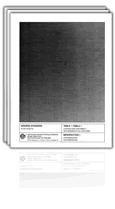Wir benötigen Ihre Einwilligung zur Verwendung der einzelnen Daten, damit Sie unter anderem Informationen zu Ihren Interessen einsehen können. Klicken Sie auf "OK", um Ihre Zustimmung zu erteilen.
ASTM D5426-19
Standard Practices for Visual Inspection and Grading of Fabrics Used for Inflatable Restraints
Name übersetzen
NORM herausgegeben am 1.2.2019
Informationen über die Norm:
Bezeichnung normen: ASTM D5426-19
Ausgabedatum normen: 1.2.2019
SKU: NS-937094
Zahl der Seiten: 6
Gewicht ca.: 18 g (0.04 Pfund)
Land: Amerikanische technische Norm
Kategorie: Technische Normen ASTM
Kategorie - ähnliche Normen:
Die Annotation des Normtextes ASTM D5426-19 :
Keywords:
airbag, cushion, grading, imperfection, inflatable restraint, inspection ,, ICS Number Code 59.080.01 (Textiles in general)
Zu dieser Norm gehören folgende Ergänzungen:
Adjunct to D5426 Practices for Visual Inspection and Grading of Fabrics Used for Inflatable Restraints
Ausgewählte Ausführung:Alle technischen Informationen anzeigen
Ergänzende Informationen
| Significance and Use | ||||||||
|
5.1 These practices are suitable for incorporation in a specification. Any reference to material or cushion specification in these practices shall mean any similar agreement between the purchaser and supplier relating to the inspection and acceptance of fabric intended for inflatable restraint use. 5.2 These practices constitute the terminology, conditions, equipment, and procedures by which rolls of inflatable restraint fabrics or cut parts are inspected and graded. 5.3 A specification incorporating these practices may deviate from them to account for considerations of fabric property, material handling equipment, or inflatable restraint cushion design, or a combination thereof. Whenever such deviations from standard occur, they are recorded in the report. 5.4 These practices acknowledge that, in the normal course of production, acceptable rolls of fabric will be produced containing imperfections; subsequently, pieces will be cut from the rolls and those pieces that contain imperfections restricted in Tables 1-5 will be culled at that time. 5.5 The accuracy in the results from visually inspecting fabric using these practices is affected by the ability of the inspector to detect, identify, and evaluate the severity of an imperfection in a moving fabric or in a cut part. Such ability can be affected by visual acuity, viewing distance, fabric traverse speed, lighting conditions, inspector discipline and training, and the availability and accuracy of suitable visual aids. 5.6 Systematic bias may result from using these practices whenever the precision or scale of the visual aids used to identify and quantify imperfections differs between the purchaser and supplier. |
||||||||
| 1. Scope | ||||||||
|
1.1 These practices cover procedures for the inspection and grading of coated and uncoated woven flat and one-piece woven (OPW) fabrics, and for the inspection and culling of cut parts made of such fabrics, all of which are used in the manufacture of inflatable restraint cushions. 1.2 For ease of reference, the scope, summary of practice, significance and use, apparatus, sampling, procedure, and report sections are listed separately for each inspection practice.
1.3 These practices can be used to distinguish those fabric imperfections that may adversely affect inflatable restraint cushion fabrication or performance from those imperfections that will not. 1.4 Procedures and apparatus other than those stated in these practices may be used by agreement of the purchaser and supplier with the specific deviations from these practices acknowledged in the report. 1.5 The values stated in SI units are to be regarded as the standard. The values given in parentheses are for information only. 1.6 This standard does not purport to address all of the safety concerns, if any, associated with its use. It is the responsibility of the user of this standard to establish appropriate safety, health, and environmental practices and determine the applicability of regulatory limitations prior to use. 1.7 This international standard was developed in accordance with internationally recognized principles on standardization established in the Decision on Principles for the Development of International Standards, Guides and Recommendations issued by the World Trade Organization Technical Barriers to Trade (TBT) Committee. |
||||||||
| 2. Referenced Documents | ||||||||
|
Empfehlungen:
EEviZak – alle Gesetze einschließlich ihrer Evidenz in einer Stelle
Bereitstellung von aktuellen Informationen über legislative Vorschriften in der Sammlung der Gesetze bis zum Jahr 1945.
Aktualisierung 2x pro Monat!
Brauchen Sie mehr Informationen? Sehen Sie sich diese Seite an.





 Cookies
Cookies
